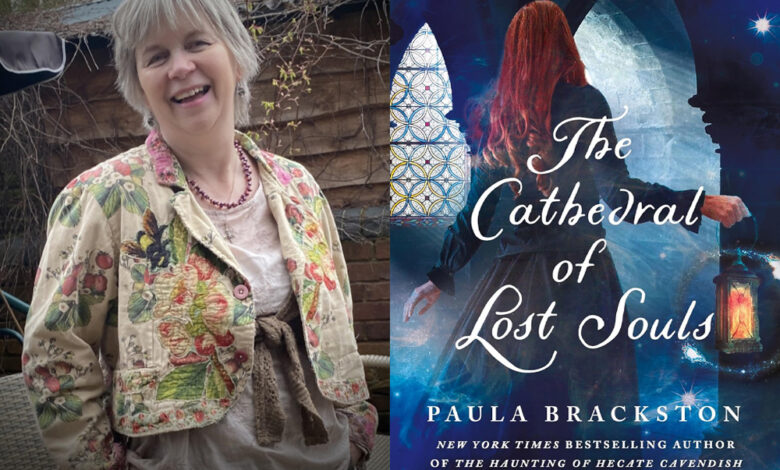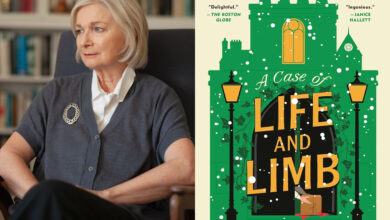Q&A: Paula Brackston, Author of ‘The Cathedral of Lost Souls’

We chat with author Paula Brackston about The Cathedral of Lost Souls, which is a magic infused series about an eccentric and spirited young woman who can see ghosts.
Hi, Paula! Can you tell our readers a bit about yourself?
Hello! I am a writer of historical fantasies, and I live in the small, ancient city of Hereford in the UK. I have two grown up children, a long suffering partner, and two demanding whippets.
When did you first discover your love for writing and stories?
Even as a small child I felt the need to write stories, to dive into imaginary worlds and people them with characters of my own invention. I think a lot of children have that sort of imagination, but they don’t always have the quiet time to develop it. I grew up in the Welsh hills and my brother and I were encouraged to entertain ourselves. Stories were a big part of that.
Quick lightning round! Tell us:
- The first book you ever remember reading: A book about a cart horse who dreams of being a racehorse. His wish is granted and he is within sight of winning an important race when the spell wears off and he changes back into a galumphing cart horse. I’m still not entirely sure what the message of the story was!
- The one that made you want to become an author: I’ve always written, but I somehow never thought it was an actual job I could do. I mean, I couldn’t see how I would ever earn a living at it. However, in my thirties I realised I would always regret it if I didn’t at least try to become a writer. Then I had to choose what type of books to write. I have always been fascinated by history and enjoyed historical fiction. The book that made me see that I didn’t have to write a bodice-ripper, a piece of women’s fiction, that historical fiction could be real and raw and funny and gripping, was “Restoration” by Rose Tremain.
- The one that you can’t stop thinking about: “As Meat Loves Salt” by Maria McCann. Another brilliant example of transporting readers to a different time. Maria does a superlative job of inhabiting the mind of an dangerous, male, unreliable narrator. I highly recommend it.
The Cathedral of Lost Souls is the second installment in your Hecate Cavendish series and it’s out November 11th! If you could only describe it in five words, what would they be?
Victorian ghostbuster, chained library, magic map. (Oops, that’s six words! Pinching an extra one, seeing as it’s nearly Christmas).
For those who haven’t picked up The Haunting of Hecate Cavendish, what can readers expect?
Hecate is a young woman ahead of her time, given to riding her bicycle in scandalously short skirts through the small, ancient city of Hereford. She has recently broken more conventions by becoming Assistant Librarian in the cathedral. The collection includes priceless chained books and a medieval map. Hecate’s other singular characteristic is that she is able to see and talk to ghosts. She quickly discovers the lost souls who haunt the cathedral and they become her friends. She also finds out more about her own destiny, learning that she has been chosen by her namesake, the goddess Hekate, to use her gift of communing with spirits to protect those in need, and help souls when no-one else can.
And for those who have, what’s to come in The Cathedral of Lost Souls?
The story continues! Book One saw Hecate battle with the terrifying Essedenes’ spirits. The threat to the city, to the cathedral, and to her family remains. In “The Cathedral of Lost Souls” she must draw on all her skills as a ghosthunter, her gifts from the goddess, and all the support of her allies, living and dead, to defeat the ruthless enemy.
Were there any moments or characters you really enjoyed writing or exploring?
I become quite fond of most of my characters, and they live, as the saying goes, rent free in my head forever. A writer can never be lonely! That said, of course there are favourites. Hecate herself appeals to me because although she is young, she is not afraid to push boundaries and defy convention. She is determined and brave, but also warm and empathetic. I wish I’d had her courage when I was in my twenties! The character I most enjoyed writing, though, was probably Phileas. Phileas James Weatherby Sterling is a friend of the family, a gentleman farmer who adores his herd of Hereford cattle and throws the most wonderful picnics which usually descend into some sort of chaos. He is the comic character in the book, and I enjoy adding the lightness he brings to the story.
Did you face any challenges whilst writing? How did you overcome them?
It’s a wonderful job, but yes, there are challenges. Some are practical, such as grappling with technology. For example, I spent a highly stressful hour yesterday searching for the file of the second draft of my latest novel. Months of work appeared to have vanished. Happily, I found it before I completely lost my mind. Some challenges are more personal, such as persuading my butterfly brain to hold its focus on the long haul of a big book rather than flitting this way and that, alighting on tasty new projects every couple of days.
What’s next for you?
I have nearly completed Book Three in the Hecate Cavendish series! The title and cover will be revealed very soon. I’m also working on several screen projects, and hope to have news of those in the new year.
Lastly, what books have you enjoyed reading this year? Are there any you’re looking forward to picking up in 2026?
I am a huge fan of audio books, and have just finished listening to “Venetian Vespers” by John Banville. Brilliantly written, with an expertly sustained voice of the main character, and filled with the foggy atmosphere of winter in 19th century Venice. A very clever book. I read anything Andrew Miller writes, (“Pure”) so will be looking for his latest. Same goes for Rose Tremain, and David Mitchell (“Cloud Atlas”).
Will you be picking up The Cathedral of Lost Souls? Tell us in the comments below!
Source link




